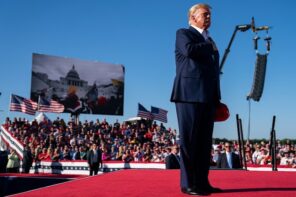On July 20, just after James Holmes wounded 58 and killed 12 people at the opening of the latest Batman film at an Aurora, Colorado movie theater, The Telegraph published a “history of mass shootings in the U.S. since Columbine”—a list of nearly 30 shooting sprees with lethal results. Ne’er-do-wells who merely wounded didn’t make the cut. Thus, not included on the list was a shooting spree in an Alabama bar with a multiple arson warm-up just two days earlier. There, enraged after having been fired from his job (only the latest in a string of personal and financial calamities), NVW fired into a bar from across the street, wounding or otherwise injuring 17 people but not killing anyone.
Likewise, the non-fatal, apparently gang-related shootings of four girls in a Chicago park on July 11 was omitted. The shooter or shooters there have not been apprehended, but Chicago mayor Rahm Emanuel offered a warning that, as I will discuss shortly, hardly helps matters for those of us who are concerned about what seems to be a growing tide of mass violence. “Take your stuff to the alley,” Emanuel was quoted as saying. “Don’t touch the children of the city of Chicago. Don’t get near them.”
Our digital-age attention spans generally being what they are, we can’t expect the Telegraph or NPR, which went more global with its list, to provide the 62 pages of gun-wielding detail offered by the Brady Campaign To Prevent Gun Violence. Still, in less than a month since the Aurora shootings, two more killers have become eligible for the newsmaker list: Wade Michael Page, for an attack on a Sikh temple in Oak Creek, Wisconsin on August 5; and Thomas Caffall, who laid siege to a College Station, Texas neighborhood this week.
Neither senseless nor random
As Caffall was taking the lives of three people and wounding two others across the street from the Texas A&M campus, Notre Dame professor Naunihal Singh complained in The New Yorker about the media’s short attention span with regard to the Oak Creek tragedy as compared to the Aurora shootings less than three weeks earlier. We all seem to have moved on quickly. Thus, when I began typing “Oak Creek shooting…” into the Google search bar, the helpful algorithm offered me listings for the “Oak Creek Sporting Club” and “Oak Creek Shooting Range” before offering up anything to do with the week-old massacre.
No wonder Singh found it “hard to escape the conclusion that Oak Creek would have… dominated the news cycle if the shooter had been Muslim and the victims had been white churchgoers.”
Singh was not alone in his seeing the Oak Creek shootings through racial, ethnic, and religious lenses. The shooting has been branded a hate crime by Attorney General Eric Holder, and within the small news window that opened in the days immediately after the melee, commentators called Americans to a deeper consideration of the violent effects of racism.
Rinku Sen, writing for Color Lines in the immediate aftermath of the rampage at the Sikh Gurdwara, pointed to a pattern that extends far beyond an individual tragedy, and well past racism, understood with reference primarily to the color of the brown-skinned, turban-wearing Other. Rather, she reoriented our vision toward the dominant race of mass killers:
Murderous insanity can infect any community, and maybe that leads people to call these senseless acts of random violence. But of course they are neither senseless nor random, and the vast majority of such incidents here involve white men. Racism holds a terrible logic, for a concept with no grounding whatsoever in science or morality, yet too many white people don’t see any patterns.
Indeed, something along these lines had prompted me to tweet my own discomfort on the morning of the Oak Creek attack:
Angry, hateful, demented white people are really bringing me down. #Aurora #ChickFilA #OakCreek
— Over-Educated Elizabeth Drescher, PhShe🌴🌈🇺🇦 (@edrescherphd) August 5, 2012
The common denominator
Others have seen religious intolerance as a central feature in many recent mass killings. Mark Juergensmeyer recently discussed the ways in which certain religious narratives meld seamlessly with notions of violence and war. The image of cosmic, religious war, he notes, can been seen at the center of both Islamist and Christianist acts of terror.
Susan Thistlethwaite links religion and racism, mapping religiously authorized ideologies of terror from the era of American slavery to present day white supremacy movements. In a lengthy discussion at the Washington Post, she suggests that Christianity has a particular role to play in American constructions of whiteness that make the risks associated with Christian extremism difficult to see, especially by law enforcement. “The face of the ‘intimate enemy’ as a domestic terror threat has now been exposed as a white face,” says Thistlethwaite. “This is a difficult concept, both in theological and in law enforcement terms.”
Race and religion are certainly root similarities among Timothy McVeigh, Jared Loughner, Anders Breivik, James Holmes, Wade Michael Page, and Thomas Caffall—all white, all Christian. But there is no shortage of non-white mass killers, many of them not Christian:
- Eduardo Sencion, a Mexican American, who killed four and wounded seven people before shooting himself in the head at a Carson City, Nevada restaurant in 2011;
- Seung-Hui Cho, a Christian, Korean American who killed 30 people and wounded 15 at Virginia Tech in 2007 before turning the gun on himself;
- Jiverly Wong, a Buddhist, Vietnamese American who killed 13 people (himself included) and wounded four in Binghamton, New York in 2009;
- John Allen Muhammad, the Islamic, African American “Beltway Sniper,” who, with Jamaica-born partner Lee Boyd Malvo, killed at least 10 people in the Washington DC area through the month of October 2002.
Many of these shooters, regardless of race or religion, had known mental health issues. Likewise, a substantial number of the men on the Brady Campaign list were not previously identified as having psychological problems, but were “driven” to violent rage by financial and relationship crises. So we cannot name any specific cluster of circumstances that prompts such behavior, though we do know that ready access to firearms is a factor.
All of which is to say, yes, the intimate enemy, the mass killer we do not want to acknowledge among us, very often has a white face—but not always. He is often, but not always, mentally ill. There have been exceedingly rare cases of mass killings by women—the most notable being professor Amy Bishop, who killed three and wounded as many after being denied tenure at the University of Alabama in 2010; and Jennifer San Marco, who “went postal” on seven people before killing herself in Goleta, California in 2006.
But by and large the common denominator in mass killing is gender; the intimate enemy is almost always a man.
If God is male, then male is God
Left unexplored in commentary such as that offered by Sen, Thistlethwaite, and Juergensmeyer is the role masculinity itself—not the biological fact of being male, but the behavioral and ideological markers of maleness that are malleable across time and culture—plays in acts of violence in general and mass violence in particular.
Given the centrality of men, masculinity, and masculinist ideologies in most world religions, it is surprising that the influence of such factors on religious and racial violence should be so difficult to engage. After all, it’s been nearly 40 years since Mary Daly’s Beyond God the Father exposed the misogynistic roots of the Judeo-Christian traditions. “If God is male, then male is God,” Daly famously argued, cementing the relationship between religious ideas of divine power and authority and masculinist practices of domination and violence.
In Daly’s wake, a generation of feminist biblical scholars—Phyllis Bird, Katie Canon, Elisabeth Schüssler Fiorenza, Kwok Pui-Lan, Amy Jill Levine, Sandra M. Schneiders, IHM, and Dolores Williams among them—put forth scholarship that both critiqued the sexist and misogynist roots of the biblical narrative, and attempted to rehabilitate religious traditions by recovering the voices of women in the Bible and offering liberatory readings of biblical texts. Such readings have hardly effected a wholesale rewiring of biblical religions, but they’ve certainly flipped a breaker here and there.
Still, in a world in which even the most progressive of religious groups struggle to move away from the He-God of the sexist tradition, the problem is clearly not solved. If we’re looking at race and religion as important elements that mass killers have drawn upon for their violent rage, there’s no reason for us to look away from associated cultural constructions of masculinity as a comparably important factor.
The sins of our religious fathers
Whatever the unique complex of psychosocial, religious, financial, moral, political, or other issues that tormented the mass killers recently populating Twitter feeds and news headlines, they all sought to solve their problems with a particular expression of gun violence that maps easily to particular configurations of masculinity—apparently across classes and political ideologies. Those of us concerned with how religious ideologies participate in narratives of domination and violence, then, would do well to explore the masculinist roots of Christianity or other religious traditions, particularly as male authority and normativity are emphasized in more conservative expressions.
Like pretty much everyone else who’s had anything to say about what seems to be turning into a summer epidemic of mass gun violence, I think we surely must begin to have informed, respectful conversations about regulating access to firearms.
We need to address the crisis in mental health care that has raged since the Reagan Administration as though it had something to do with our everyday lives. Because clearly it does.
Certainly, we need to disabuse ourselves of the illusion many entertained after the election of Barack Obama in 2008, that we now live in a “post-racial era.” We need to talk sensibly and compassionately about systemic racism and the ways in which it poisons the whole nation.
And, we need to revisit with open hearts the ways in which the sins of our religious fathers—which remain too often echoed in churches, synagogues, mosques, gurdwaras, and temples today—make the resources of our faith traditions available for violent cooptation.
However, if we do all of these things and refuse to look at the role of culturally, politically, socially, and religiously sanctioned and normalized masculinities in racism, misogyny, sexism, and violence, we will do no more than teach the “intimate enemy” better manners to cast aside when frustrations mount, when his mental wiring frays, when the world reveals itself as far less under his control than his guns and his church and his hate broadcast idols have led him to believe.
When an angry man reaches into his bag…
Of course this focus on masculinity and violence makes many people uncomfortable; particularly men, and perhaps especially those who aren’t chest-thumping, gun-toting, Christianist, racist extremists. For many women, and others who have a wide range of warm and respectful relationships with wonderful men, tagging cultural constructions of masculinity as factors in this kind of violent rage is troubling.
Yet we cannot begin to address the culture of violence that’s literally exploding all around us without acknowledging that “manning up” in American culture too often involves actions aimed at the subordination of others—women, children, nature—to the will of a man who, it is assumed, embodies the will of God. These often religiously informed, institutionalized, and naturalized versions of masculinity play no small part in the continuum of violence that moves from the domestic sphere to the public arena.
As gender scholar Raewyn Connell has noted:
There are many causes of violence, including dispossession, poverty, greed, nationalism, racism, and other forms of inequality, bigotry and desire. Gender dynamics are by no means the whole story. Yet given the concentration of weapons and the practices of violence among men, gender patterns appear to be strategic. Masculinities are the forms in which many dynamics of violence take shape.
Commentators over the past several weeks have begun what we can only hope will be productive conversations about the “many causes of violence,” pressing for deeper, more informed examinations of race, religion, the mental health care system (or lack thereof), and gun regulations (or the lack thereof) as factors in the complex dynamics of violence. As Connell makes clear, other factors are certainly at play.
Indeed, as I was attempting to finish this piece, a shooting at the Family Research Council offices in Washington, D.C.—this time not lethal, this time with only one victim—prompted The New Yorker’s Amy Davidson to ask about the ways in which incendiary political rhetoric and “the problem of guns” play into escalating gun violence:
Why, in this country, when an angry man reaches into his bag, is it so easy and common for his fingers to find a gun? (Emphasis added.)
Surely, it’s a vexing and complicated question with no single, simple answer. Still, I have to wonder, is it just me, or does the smoking gendered pronoun lay in plain sight in almost every one of these cases? When will we begin to examine the evidence right in front of our eyes?





